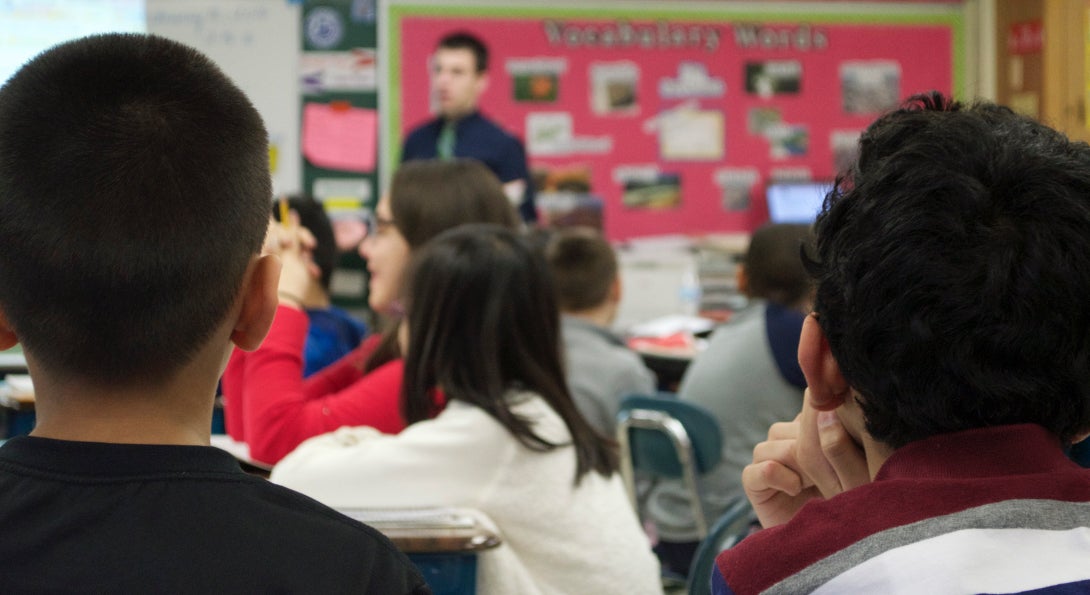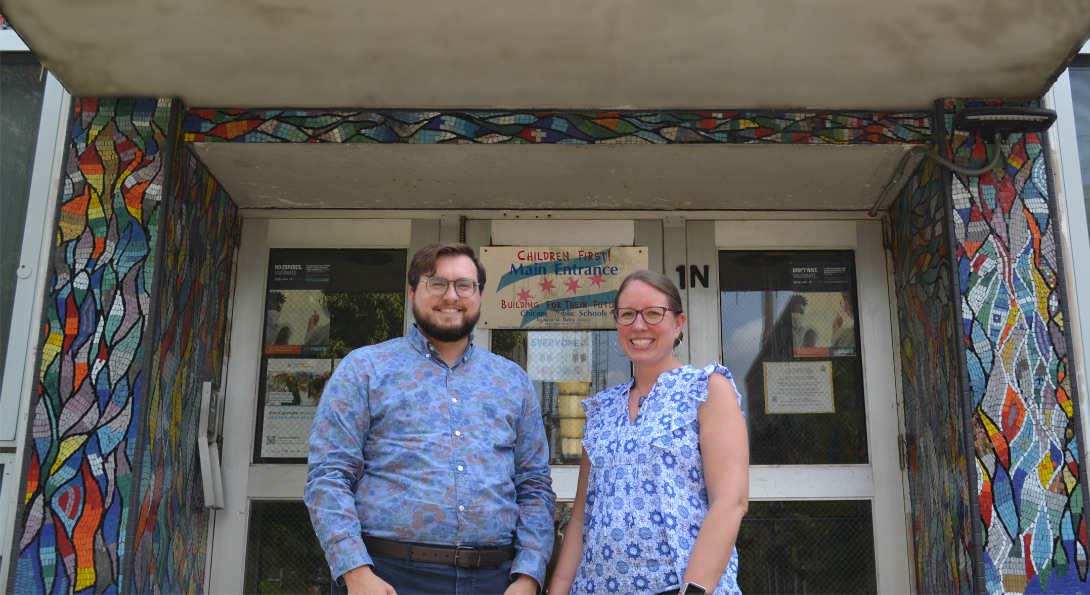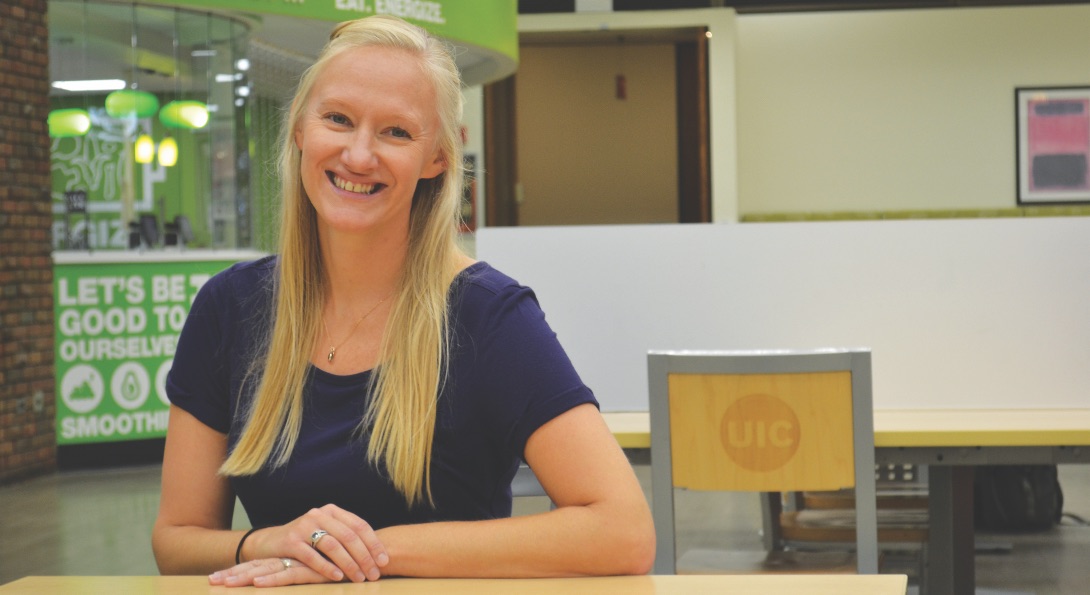Whole Child Wellness

With American schools addressing a litany of socioeconomic disparities, SPH researchers are modeling how schools can strengthen mental, physical and emotional health.
Introduction Heading link
In December 2021, U.S. Surgeon General Vivek H. Murthy, MD, issued a public health advisory identifying a crisis facing the country: the mental health of the nation’s youths. While young people battling depression, anxiety and hopelessness was not a new phenomenon, Murthy noted “alarming increases in the prevalence of certain mental health challenges” and called for “an all-of-society effort,” including earnest action from researchers and schools.
At the UIC School of Public Health, faculty members have a lengthy history of research, programming and partnerships addressing youth mental health, particularly in K-12 schools. Three current efforts underscore SPH’s commitment to championing young students’ mental health alongside their physical well-being.
A specialist to support "whole child" health Heading link

In September 2019, Jamie Chriqui, PhD, MHS, senior associate dean and professor of health policy and administration, and colleagues at the SPH’s Policy, Practice and Prevention Research Center (P3RC) began working with Chicago Public Schools’ (CPS) Office of Student Health and Wellness (OSHW) on an enterprising pilot program to support the district’s existing Healthy CPS initiative.
An expansive effort to eliminate health-related barriers, the multi-layered Healthy CPS initiative encompasses dozens of local, state and federal policies related to student health and wellness, ranging from nutrition and physical activity to mental health and social-emotional well-being. To confront the potentially dizzying array of policies and drive “whole child” health, Chriqui and her team worked with CPS officials to conceptualize, develop and then test a Healthy CPS network specialist role in one of the district’s 18 geographic networks.
“It is vital that schools have support to navigate and implement an initiative as broad as Healthy CPS,” said Chriqui, a renowned expert in school wellness policy work.
The team selected an elementary school network on Chicago’s west side – one covering 28 schools and more than 4,000 students – and P3RC planned an efficacy study to evaluate the effectiveness of the specialist’s role. In spring 2020, the appointed specialist began providing Healthy CPS-aligned information and advanced support, such as resource referrals, technical assistance and strategy, in the west side network’s schools.
“We envisioned the specialist as someone who could help school leaders make sense of the Healthy CPS framework and identify the necessary resources to support student health,” said Tarrah DeClemente, MPH ’12 with a concentration in health policy and administration and the executive director of OSHW.
In its 2019 Healthy CPS survey, the year prior to the specialist’s arrival, schools in the pilot network met 72 percent of Healthy CPS criteria. In the 2023 survey, the average score for the pilot network increased to 80 percent. By contrast, the average Healthy CPS for all other networks in the district basically did not change (73 percent in 2019 versus 74 percent in 2023).
“We call this the ‘Specialist Effect,’” Chriqui said. “With a gatekeeper and navigator helping schools focus on Healthy CPS, the schools in our pilot network didn’t miss a beat even while going against severe headwinds from the pandemic.”
Chriqui said those results offer compelling reason for deploying the specialist role across CPS. The work also serves as a model for other districts eager to boost students’ physical and mental health.
“We have proof of concept here that the specialist role can support schools and all aspects of students’ well-being,” Chriqui said.
DeClemente called Chriqui’s team “extremely collaborative and solutions oriented” in pursuit of school communities supporting the whole child.
“This partnership is making a difference in our work as an office and a district,” DeClemente said.
Evaluating strategies to support LGBTQ+ students Heading link

In CPS, the nation’s fourth largest school district with more than 300,000 enrolled students, Booker Marshall, MPH ’17 with a concentration in community health sciences, manages the OSHW LGBTQ+ and Sexual Health team. It’s an expansive role in which Marshall and their team oversee varied efforts to promote and strengthen students’ physical and mental health, including programs supporting LGBTQ+ students.
“This work is important because it prioritizes students with marginalized identities,” Marshall said. “The goal is for schools to be safe and supportive environments for all of our students.” Marshall’s work is funded by a Centers for Disease Control and Prevention- issued cooperative agreement through the agency’s Division of Adolescent and School Health. With that cooperative agreement, CPS is required to work with an evaluator to assess progress and effectiveness. Enter Elizabeth Jarpe- Ratner, PhD ’18 with a concentration in community health sciences, a DrPH core faculty member in the division of health policy and administration and a P3RC investigator. Each year, Jarpe-
Ratner meets with Marshall’s team to identify its goals and to structure an evaluation around its objectives.
This academic year, for example, Marshall’s group aimed to increase the number of Gender and Sexuality Alliances (GSAs) in schools, which have shown improved outcomes for the district’s LGBTQ+ students, and to also install a mentorship program for new GSA sponsors providing individuals more support and guidance in starting GSAs.
“My role is to support the work of the CPS team, which includes helping them execute upon their strategies, decisions and objectives. Then, we want to assess implementation and experiences of staff and students regarding the policies being implemented, so schools are building capacity, putting the proper policies in place and ensuring the appropriate deployment of resources,” said Jarpe-Ratner, a collaborator with CPS since 2013.
In past years, the CPS team sought to advance staff training on gender and sexuality issues, promote visible signs and symbols of support for LGBTQ+ students, implement LGBTQ+ inclusive curricula and enforce non-discrimination, Title IX and transgender inclusion policies. Jarpe-Ratner, Marshall and five colleagues detailed their extensive and promising efforts to support CPS’s LGBTQ+ students in the July 2022 edition of Health Promotion Practice.
“CPS is ahead of the curve here, and its work can be a blueprint and source of guidance for other districts,” Jarpe-Ratner said.
In fact, Jarpe-Ratner called it “huge” to have a prominent school district making this investment given “significant and disturbing data” around higher rates of suicidal thoughts, suicide attempts and substance abuse among LGBTQ+ youths. In addition, LGBTQ+ youths report more school days missed because they feel unsafe, lonely or depressed.
“This is literally lifesaving,” Jarpe-Ratner said of CPS’s efforts. “There’s strong evidence to show that the presence of bullying and harassment policies, GSAs and other policies that support LGBTQ+ youth in schools lessens the risk of those feelings or behaviors.”
Lunch debt, stigma and social-emotional health Heading link

Nearly two decade ago, a team of SPH researchers began collecting information on state laws related to school nutrition and physical activity as part of the National Cancer Institute’s Classification of Laws Associated with School Students (CLASS). In doing so, the SPH researchers stumbled upon an unexpected student health issue that had nothing to do with the foods available in the cafeteria line yet held potentially significant implications for students’ social-emotional wellness and mental health.
To address the hunger problem in the U.S., certain students qualify for free or reduced lunch. In many cases, students must apply for free or reduced lunch, a process challenged by community messaging or language barriers that can – and often do – result in eligible students paying full price and racking up lunch debt. In other cases, students without the ability to pay might receive an alternative meal that creates stigma as they navigate the lunchroom. And neither outcome, UIC researchers reasoned, seemed in the students’ best interest.
Investigating state laws regarding lunch debt, the SPH team uncovered widely varying policies. Nine states served a meal with no questions asked; six states required that students be served a meal but failed to limit overt identification or alternative meals; seven states acknowledged the potential stigma around lunch debt yet provided no actionable strategies to schools; and eight states served a meal for only a predetermined number of days.
“While we were hoping to find laws always protecting students from hunger and stigma, we only found nine states doing this,” said Betsy Porter, JD, clinical assistant professor of health policy and administration. “If kids are not eating or being shamed or stigmatized, there’s an impact to their social-emotional learning, growth and overall health.”
Over recent years, Porter, a licensed attorney, has led UIC’s surveillance effort around lunch debt, spotlighting state policies and implementation strategies to drive awareness and education around the issue. For example, the SPH-based group has reviewed state efforts to provide meals to all students and tracked interventions such as meal eligibility outreach.
“Anyone can use our data to figure out what’s working and not and then explore implementation in their own worlds,” Porter said. “Step one, though, is knowing what the policy says and figuring out how to make it better. The hope is policymakers and district leaders think about ways these policies impact kids throughout the school day.”
Lunch debt has become an increasingly important issue over the last year. In summer 2022, pandemic-era waiver provisions to federal programs assuring every child could receive free breakfast and lunch at school expired.
“Knowing students have a consistent source of at least lunch would certainly go a long way to reduce stress, improve mental health and, hopefully, foster the overall well-being for kids in this situation,” Porter said.